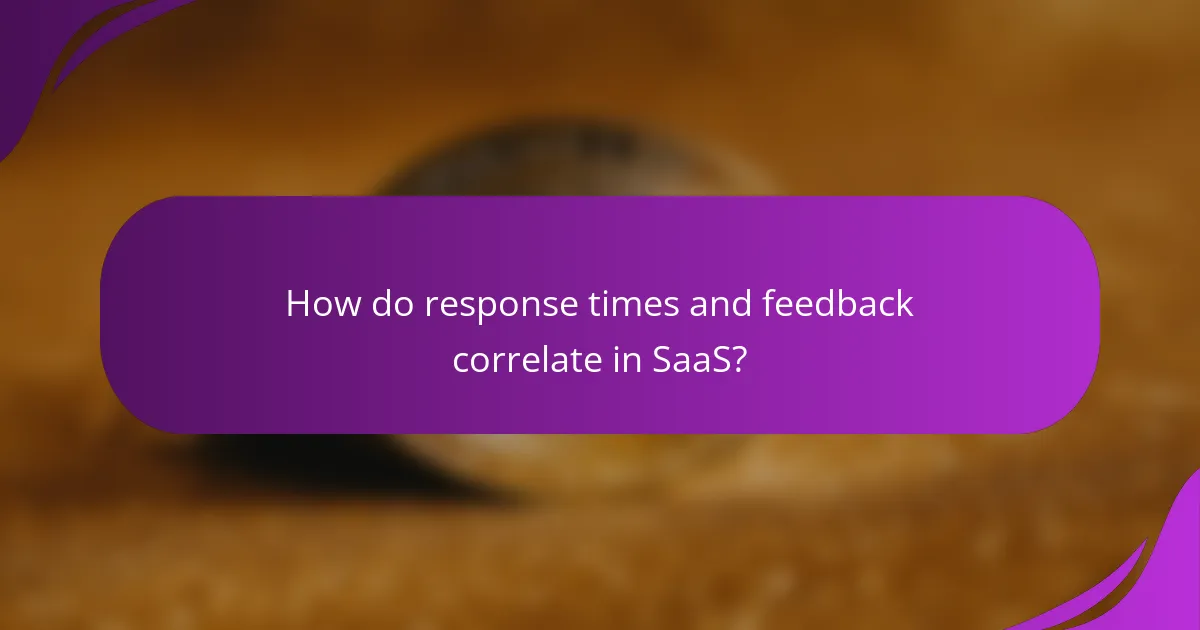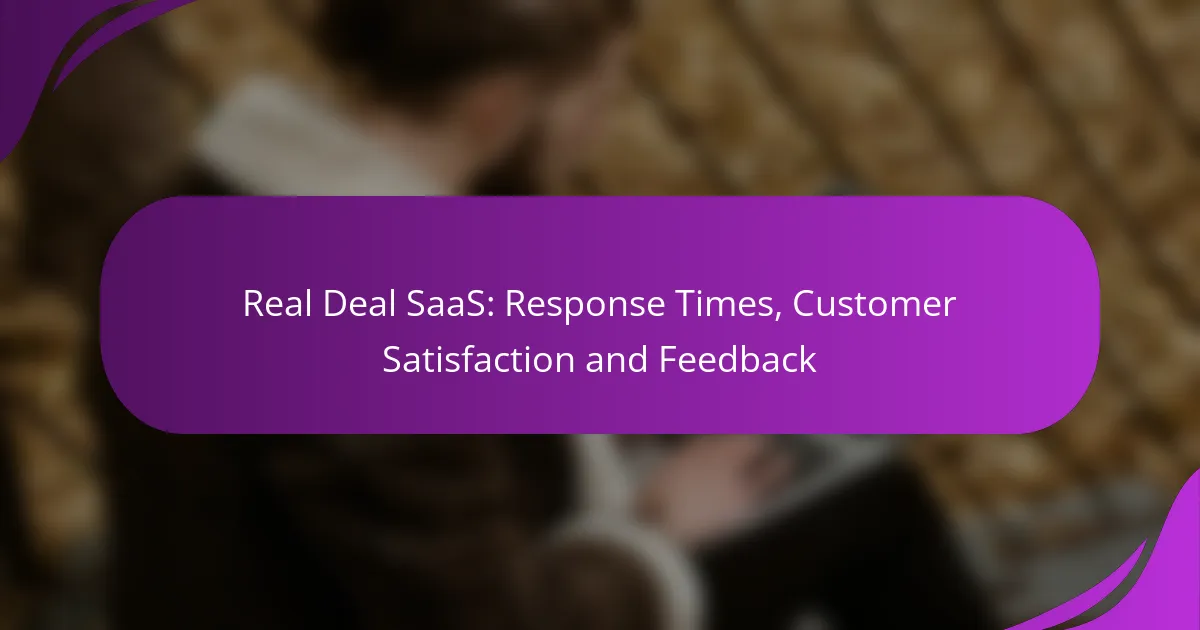
How do response times affect customer satisfaction in SaaS?
Response times play a crucial role in customer satisfaction for Software as a Service (SaaS) products. Quick responses can enhance user experience, while delays often lead to dissatisfaction and frustration.
Faster response times improve satisfaction
When customers receive prompt responses, their overall satisfaction with the service increases significantly. Fast response times, typically within a few minutes to a couple of hours, help users feel valued and supported.
For example, a SaaS company that responds to support tickets within 30 minutes can expect higher customer retention rates compared to one that takes several days. Implementing chat support or automated responses can further enhance these response times.
Slow responses lead to frustration
Slow response times can create frustration among users, leading to negative perceptions of the service. If customers wait for hours or even days for assistance, they may feel neglected and consider switching to competitors.
To mitigate this, companies should aim for response times of under one hour for urgent issues. Regularly monitoring response metrics and gathering customer feedback can help identify areas for improvement and prevent dissatisfaction.

What are the average response times for top SaaS platforms in the US?
The average response times for leading SaaS platforms in the US typically range from a few minutes to several hours, depending on the service level agreement (SLA) and the complexity of the issue. Fast response times are crucial for customer satisfaction and can significantly impact user retention.
Salesforce response time benchmarks
Salesforce generally aims for a response time of under one hour for critical issues, with many customers reporting resolutions within a few hours. For non-critical inquiries, response times can extend to 24 hours or more, depending on the support tier selected.
To enhance response times, Salesforce encourages users to utilize their online resources, such as the knowledge base and community forums, which can often provide immediate answers to common questions.
Zendesk average response rates
Zendesk’s average response time varies based on the support plan, with standard support typically responding within 24 hours. However, premium plans can see responses in as little as a few hours, particularly for urgent requests.
Zendesk also emphasizes the importance of self-service options, allowing customers to find solutions quickly through their help center, which can reduce the need for direct support and improve overall satisfaction.

How can SaaS companies improve their response times?
SaaS companies can enhance their response times by adopting advanced technologies and refining their support workflows. Implementing AI-driven solutions and optimizing processes are key strategies that lead to quicker resolutions and improved customer satisfaction.
Implementing AI chatbots
AI chatbots can significantly reduce response times by providing instant answers to common customer inquiries. These bots operate 24/7, allowing users to receive assistance outside of regular business hours, which is particularly beneficial for global customers across different time zones.
When integrating chatbots, it’s essential to ensure they are well-trained on frequently asked questions and can seamlessly escalate complex issues to human agents. This hybrid approach balances efficiency with personalized service, maintaining customer satisfaction.
Streamlining customer support processes
Streamlining customer support processes involves evaluating and refining existing workflows to eliminate bottlenecks. This can include adopting ticketing systems that prioritize urgent requests or implementing a knowledge base that empowers customers to find solutions independently.
Regularly reviewing response metrics can help identify areas for improvement. For instance, aiming for first response times within single-digit minutes can enhance overall customer experience. Training staff on efficient communication techniques also plays a crucial role in reducing resolution times.

What role does customer feedback play in SaaS?
Customer feedback is essential in SaaS as it informs product development and enhances user satisfaction. By actively collecting and analyzing feedback, companies can identify areas for improvement and adapt their offerings to better meet user needs.
Feedback drives product improvements
Customer feedback directly influences product enhancements by highlighting specific features that users find valuable or lacking. For instance, if multiple users request a particular functionality, the development team can prioritize its implementation in future updates. This iterative process ensures the product evolves in line with user expectations.
Moreover, feedback can reveal bugs or usability issues that may not be apparent during internal testing. Addressing these concerns promptly can significantly improve overall product quality and user retention.
Customer feedback enhances user experience
Incorporating customer feedback into the user experience design leads to a more intuitive and satisfying product. By understanding user pain points, companies can streamline workflows and reduce friction in the user journey. For example, simplifying navigation based on user suggestions can make the software more accessible.
Additionally, actively engaging with customers and showing that their opinions matter fosters loyalty. Regularly updating users on how their feedback has shaped product changes can strengthen the relationship and encourage ongoing input.

How can SaaS companies effectively gather customer feedback?
SaaS companies can effectively gather customer feedback through structured methods like surveys, polls, and interviews. These approaches help capture user experiences and satisfaction levels, enabling companies to make informed improvements.
Using surveys and polls
Surveys and polls are straightforward tools for collecting customer feedback. They can be distributed via email, integrated into the software, or shared on social media platforms. Aim for concise questions to maximize response rates, ideally keeping surveys under 10 questions.
Consider using a mix of quantitative and qualitative questions. For example, a rating scale can quantify satisfaction, while open-ended questions allow for detailed insights. Offering incentives, such as discounts or free trials, can also encourage participation.
Leveraging customer interviews
Customer interviews provide in-depth insights into user experiences and expectations. Conducting one-on-one interviews allows for a deeper understanding of customer needs and pain points. Schedule these interviews at convenient times for customers to ensure better participation.
Prepare a set of open-ended questions to guide the conversation, but remain flexible to explore unexpected topics. Recording interviews (with permission) can help capture details that may be missed during note-taking. Aim for a diverse range of participants to gather varied perspectives.

What are the best practices for analyzing customer feedback?
To effectively analyze customer feedback, it’s essential to systematically collect, categorize, and interpret the data to identify trends and areas for improvement. Best practices include utilizing technology for analysis and ensuring that insights lead to actionable changes.
Utilizing sentiment analysis tools
Sentiment analysis tools help businesses gauge customer emotions by processing feedback through natural language processing algorithms. These tools can categorize comments as positive, negative, or neutral, providing a quick overview of customer sentiment. Popular options include tools like MonkeyLearn and Lexalytics, which can analyze large volumes of feedback efficiently.
When implementing sentiment analysis, consider the context of the feedback. For instance, a negative comment about a specific feature may indicate a need for improvement, while positive feedback can highlight strengths. Regularly reviewing sentiment trends can help track changes over time and inform strategic decisions.
Creating actionable insights from feedback
Transforming feedback into actionable insights involves identifying key themes and prioritizing them based on their impact on customer satisfaction. Start by categorizing feedback into common themes, such as product features, customer service, or pricing. This helps pinpoint specific areas that require attention.
Once themes are identified, prioritize them based on frequency and severity. For example, if multiple customers express dissatisfaction with a particular feature, it should be addressed promptly. Regularly updating stakeholders on these insights ensures that the organization remains aligned with customer needs and expectations.

How do response times and feedback correlate in SaaS?
Response times and customer feedback in SaaS are closely linked; quicker responses typically lead to higher satisfaction levels. When users receive prompt support, they are more likely to leave positive feedback, enhancing the overall perception of the service.
Quick responses lead to more positive feedback
When customers receive timely responses, their satisfaction increases significantly. Quick resolutions to inquiries or issues can create a sense of reliability and trust in the service. For example, a SaaS company that responds within a few minutes can expect positive reviews from users who appreciate the efficiency.
Moreover, rapid feedback loops can encourage users to engage more with the platform. If they know their concerns will be addressed swiftly, they are more likely to provide constructive feedback, which can further improve the service.
Long response times can skew feedback negatively
Conversely, long response times often lead to frustration and negative feedback. Users may feel neglected if their issues take hours or days to resolve, which can tarnish the company’s reputation. A delay of even a few hours can result in dissatisfaction, especially in competitive markets.
To mitigate this, SaaS providers should aim for response times in the low tens of minutes. Establishing clear communication about expected wait times can also help manage customer expectations and reduce negative feedback.

What are the implications of customer satisfaction on SaaS retention rates?
Customer satisfaction significantly impacts SaaS retention rates, as satisfied customers are more likely to continue using a service. High levels of satisfaction create loyalty, while dissatisfaction can lead to customer churn.
High satisfaction increases retention
When customers are satisfied with a SaaS product, they are more inclined to renew their subscriptions and recommend the service to others. This loyalty can translate into long-term revenue stability for the provider. Companies often see retention rates improve by tens of percent when customer satisfaction is prioritized.
To enhance customer satisfaction, SaaS providers should focus on delivering exceptional user experiences, timely support, and regular updates. Implementing feedback loops, such as surveys and user interviews, can help identify areas for improvement and foster a customer-centric culture.
Low satisfaction leads to churn
Low customer satisfaction can result in increased churn rates, where users discontinue their subscriptions. Factors contributing to dissatisfaction may include poor response times, lack of features, or inadequate customer support. Even minor issues can prompt customers to switch to competitors.
To mitigate churn, SaaS companies should actively monitor customer feedback and address concerns promptly. Establishing a robust customer support system and providing clear communication can help retain customers even when issues arise. Regularly reviewing performance metrics and customer satisfaction scores can guide necessary adjustments to improve service quality.
